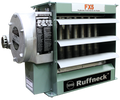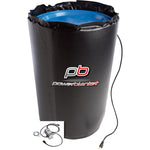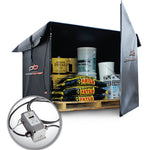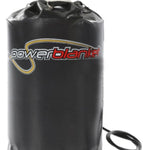You have no items in your shopping cart.
Article At-a-Glance
What Are the Best Heating Options for Warehouses?
The best heating options for warehouses include natural gas or propane heaters for cost-effectiveness and efficiency, electric heaters for smaller spaces, geothermal systems for long-term savings, and radiant heating for targeted warmth, with each option offering unique benefits depending on the warehouse's size, layout, and specific heating needs.
Key Takeaways
- Explore Diverse Heating Systems: Understand the range of heating options available for warehouses, including natural gas, propane, electric, geothermal, and radiant heating, each suited for different space sizes and layouts.
- Evaluate Efficiency and Cost: Compare the efficiency and cost-effectiveness of each heating method, considering factors like energy consumption, installation costs, and long-term savings potential.
- Consider Fuel Types: Learn about the various fuel choices such as natural gas, propane, and electricity, and how they impact operational costs and suitability for your specific warehouse environment.
- Tailor Solutions to Your Space: Discover practical tips for customizing heating systems to accommodate unique warehouse features like ceiling heights, door placements, and open floor plans, ensuring optimal warmth and safety.
- Prioritize Safety: Identify the safest heating options for industrial settings, focusing on minimizing risks associated with combustion, venting, and maintaining a safe working environment.
Warehouse Heating Options: How to Choose the Right One for Your Business
Heaters are an important part of industrial settings, like warehouses and factories, as they keep workers warm and productive. This is especially important in the winter when temperatures can be quite low. Heaters can also help to improve worker productivity by keeping them happy and focused.
Selecting the right heater needs to meet a number of important criteria that will result in a comfortable environment for workers, as well as a safe place to store materials. These three criteria are efficiency, cost, and safety. Read on to learn how to choose the best heater option for your warehouse.

$5,984.00 USD
FX5 Explosion-Proof Electric Air Unit Heater w/ Thermostat
When you are ready to safely heat your workspace, check out our explosion-proof heater units to maintain both comfort and safety in your industrial setting.
Efficiency
What is the most efficient way to heat a warehouse?
Heating large rooms like warehouses is best done with multiple heating devices. Spread across the ceiling, walls, or floor, the right placement of heaters can provide warmth throughout the building.
There are many types of industrial heaters for different environments. The most efficient way to heat a warehouse depends on several factors, such as the size of the warehouse, airflow, and the type of activities taking place inside. Here are some of the most common and efficient ways to heat a warehouse:
- Natural gas or propane heating are commonly used in warehouses due to their cost-effectiveness and efficiency. These heaters work by burning gas to create heat, using a fan to circulate warm air throughout the warehouse space.
- Electric heaters work best in smaller warehouses or for areas that need occasional heating. In the long run, they may not be as efficient as other methods if used for continuous heating.
- Geothermal heating uses the earth's natural heat to warm up a building. This method is more expensive to install, but it can be more efficient and cost-effective in the long run.
- Radiant heating uses infrared radiation to warm up objects and people inside the warehouse, rather than heating the air. This method can be more efficient than traditional heating systems because it only heats the areas that need to be heated and can provide more comfortable temperatures without heating up the entire warehouse.
In addition to each of these heating methods, it’s wise to ensure that the warehouse is properly insulated to prevent heat loss. We also recommend using a programmable thermostat to regulate room temperature.

Cost
What is the cheapest way to heat a building?
Nearly all businesses these days are looking to cut costs. Reducing the amount of energy needed to heat a building is one of these ways, but too much cutting and you’re left with a cold warehouse.
Heating an entire warehouse usually means using lots of fans blowing air over heat exchangers, and then carrying that air throughout the facility. These sources of heat often take the form of electric coils or gas burners, which can be expensive to rely on as energy prices continue to rise. There are alternatives, however, that can be much more economical in the long run.
Are radiant floor heaters low-cost?
Other heating methods involve looking not up, but down. Radiant floor heating uses heating elements embedded within concrete floors to keep heat close to the warehouse surface. The benefit of radiant floor heating is that air higher than 6 feet off the ground doesn’t need to be heated. However, radiant flooring can’t help you if you don’t own the warehouse or have the capital to install it.
Are fan heaters a cheap heating solution?
Fan heaters are cheap to purchase. Plug-in fans with heating coils are simple to use and quick to replace, but use high amounts of electricity. They might seem like a low-cost solution, but they will inevitably incur higher costs for your business.
Will an infrared heater heat a room?
Infrared heaters can be extremely efficient at heating rooms, and are even useful at warming entire warehouses. They run on electricity, which can be expensive depending on where your business operates. However, warehouse spaces that are often dusty can lead to the smell of burning dust particles from the heater.

Safety
Which heaters are best for workplace safety?
Heating in hazardous areas can be perilous if safety standards are not adhered to. One of the most dangerous things you can do in an industrial warehouse space is to introduce unsafe heating equipment. It might be efficient, and it might be cheap, but selecting and installing heaters that aren’t right for your workplace will increase safety risk.
Selecting heaters for industrial settings
When choosing heaters for an industrial setting, it’s important to consider the size of the area that needs to be heated, the type of work that will be done in that area, and the safety of the workers. That last point is incredibly essential, as the right warm-air heater for your warehouse space should only increase safety, not risk.
Here are other factors to consider when considering which heaters are safest to use in industrial settings:
- Low temperatures: Heaters that don’t draw enough warm air throughout the warehouse won’t do enough to keep your workers warm. If they get cold, they’ll lose productivity and possibly neglect safety procedures that prevent accidents.
- Too much heat: Some heaters generate large amounts of heat, which is great if you have a way to distribute it quickly throughout the warehouse. However, a high concentration of heat could cause materials near the heater to combust, leading to a fire or even an explosion.
- Venting: Heaters that give off gasses unsafe for breathing are also not recommended for warehouses. Warehouses tend to be virtually sealed during winter months, reducing the amount of fresh air that would usually remove unbreathable air.
- Combustion: Like the above factors, concentrated heat isn’t great for work environments like paper mills and grain elevators. Heaters that burn natural gas rely on open flame to generate warmth. Flames are forbidden in these kind of places, as the resulting explosion would be devastating.
Explosion-proof heaters

Keeping your employees safe can be difficult enough with heavy machinery, loud noises, and tight schedules. Making sure they’re warm while working doesn’t have to be an additional challenge. Explosion-proof heater units allow for increased comfort and improved safety in the workplace.













